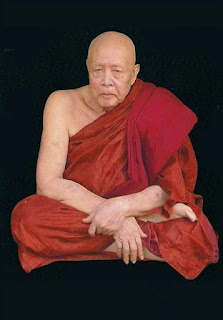Made : 278 pieces
No. : 139
*Inside of the amulet come with a small little Kring (ball bearing). Believe that shaken 3 times before you leave your home to give you good luck for the day.
This amulet can bring wealth, good business and good luck to a worshipper.
No. : 139
*Inside of the amulet come with a small little Kring (ball bearing). Believe that shaken 3 times before you leave your home to give you good luck for the day.
This amulet can bring wealth, good business and good luck to a worshipper.
Luang Phor Thong Dum was born on 19 August B.E.2477 in the village of Prangu in Sri Saket Province; he was the third child of his parents’ of four childrens.
When Thong Dum Puiob (LP Thong Dum’s actual name) was still young he studied at Wat Ban Prasat and continued to do so until the age of ten. But due to the fact that his family was suffering from poverty he had to quit his studies at the temple and go back to his parents’ house to help his family out in farming their land.
At the age of twenty-two LP Thongdum went to study with various teachers, such as Phra Kru Virutammagij, Ajahn Ngow and Ajahn Poh at Wat Samoh, at the Prangu District in Sri Saket Province. After some time he reached higher levels of Dhamma studies. Then LP Thongdum went to LP Mun of Wat Prasat Yea Neua and Ajahn Thongsook of Wat Ban Pet who taught him the Wiccha (magic). LP Thongdum also received teachings on Sak Yant (thai traditional tattoo) from Ajahn Thongsook.
However, soon after he had completed his studies with Ajahn Thongsook he was assigned as abbot of Wat Prasat Jant Ngo. He spent a period of twelve years to rebuilding the temple as instructed by LP Mun. When the temple was finally fully rebuilt, LP Thongdum resumed his tudong.
During one of his tudongs, he traveled through Ubon Ratchathani where he met Ajahn Hom who is believed that he had attained a very high level in meditation practice. Therefore, LP Thongdum decided to take a break from his tudong practice and went to practice meditation together with Ajahn Hom. When they stayed in the forest, LP Thongdum simultaneously continued his wiccha practice.
Every morning he will join Ajahn Hom for alms round across the border into Laos. After many years of learning LP Thongdum finally completed his studies with Ajahn Hom. After bidding Ajahn Hom goodbye, LP resumed his tudong and he was given a Buddhist scripture (Phra Dhamma Gaow Goti) by Ajahn Hom.
B.E.2512; LP Thongdum arrived at Lopburi. When he was taking a rest at Tham Phra Narai Khao Wong, he got invited by Nang Pisamai to an eerie and quiet place, which later known as Wat Tham Tha Pien Thong. Back in the days, most people believed that it was haunted, so nobody dared to go in there. LP Thongdum couldn’t care less and decided to stay there. Then he found a undiscovered cave. Thus, LP Thongdum decided to reside in this cave.
The news spreaded fast and soon many people would come to visit LP Thongdum in the cave. At that time LP Thongdum would start to do sak yant for his devotees. As time passed LP Thongdum’s sak yant became very well known. Unfortunately some of his devotees misused LP Thongdum’s sak yant to do bad things which soon led to LP being summoned by the government and ordered him to stop doing sak yant.
Later, in the years from B.E.2520 to 2524, LP Thongdum got frequently invited to Bangkok for ceremonial blessing rituals. During that time he met many other well known monks, such as LP Toh of Wat Pradoochimplee; LP Eia of Wat Bandan; LP Kammi of Wat Tham Kuha Sawan; LP Tit of Wat Paleelai; LP Sud of Wat Kalong; and LP Pring of Wat Bod Gong Tanu.
During one of his visits to Bangkok LP Thongdum recognized LP Toh’s profound skills in samadhi. Thus, LP Thongdum took the opportunity to study from LP Toh as well. Since then, he resides in Wat Tham Tha Pien Thong where he started to make amulets.
LP Thongdum is the first monk who created style of Phra Khun Paen Jao Sup Jao Saneh in present-time and popular for his knowledge in both holy Dharma and Wiccha magic. He studied arcane sciences in making efficacious Phra Khun Paen amulets from Cambodian masters.
Jao Sup Jao Saneh amulet series was made by LP Thongdum’s hand for the first time with ancient Katha from Cambodia one by one for more than one year. On the front presents Phra Khun Paen sitting inside a decorated roof. At the back are 3 Takruts - gold, silver, copper. All the takruts used by LP Thongdum had been written with Yahn Script “Na Setthi” and “Na Khun Paen”. These takruts are known to be very powerful that could bring luck, wealth and help the owner to be admired and people believed that Phra Khun Paen by LP Thongdum has the power in protecting the owner from black magic, evil and bad luck.
However, we must highlight that it is one's own Karma the deciding factor in overcoming those shortcomings. Also, this amulet is especially powerful in securing good fortune in business affairs to the owner. The 1st batch of this Jao Sup Jao Saneh series was made in small quantity and is hard to find nowadays. But do not be disheartened because the 2nd batch worked just fine. From findings this 2nd batch may have been released several times between B.E.2546 till B.E.2549.
九面佛又称富贵佛或九面富贵佛。富贵佛有两种法相造型,
另有一种传说,九面佛(Phra Gao Nha)是印度五大天神合体,结合了大梵天王、湿婆、毗
有关九面佛的由来,相信很多泰国信徒也无从解答,因为九
这时,有一位修为极高的苦行僧来到此地,见人民一片愁容
当时的皇帝得知此事后,就亲自来到广场膜拜这位奇僧。皇
该佛像将永远护持这个国家,但佛像必须用菩提树雕刻,雕
这尊九面佛还有一个殊胜的法名,那就是”柏实提纳哇苛“
刚进入广场,已见奇僧坐在当中并说:“我已久等了”。皇
督造九面富贵佛,除了特别的法门,更需要一种知名的圣料
在泰国,九面佛代表成功与富贵,九个面代表富贵佛不同的
据说善信祈拜或佩戴九面佛,将得到九尾已证得阿罗汉果位
Thanks for people who support us. This amulet has been rented.
另有一种传说,九面佛(Phra Gao Nha)是印度五大天神合体,结合了大梵天王、湿婆、毗
有关九面佛的由来,相信很多泰国信徒也无从解答,因为九
这时,有一位修为极高的苦行僧来到此地,见人民一片愁容
当时的皇帝得知此事后,就亲自来到广场膜拜这位奇僧。皇
该佛像将永远护持这个国家,但佛像必须用菩提树雕刻,雕
这尊九面佛还有一个殊胜的法名,那就是”柏实提纳哇苛“
刚进入广场,已见奇僧坐在当中并说:“我已久等了”。皇
督造九面富贵佛,除了特别的法门,更需要一种知名的圣料
在泰国,九面佛代表成功与富贵,九个面代表富贵佛不同的
据说善信祈拜或佩戴九面佛,将得到九尾已证得阿罗汉果位
Thanks for people who support us. This amulet has been rented.


